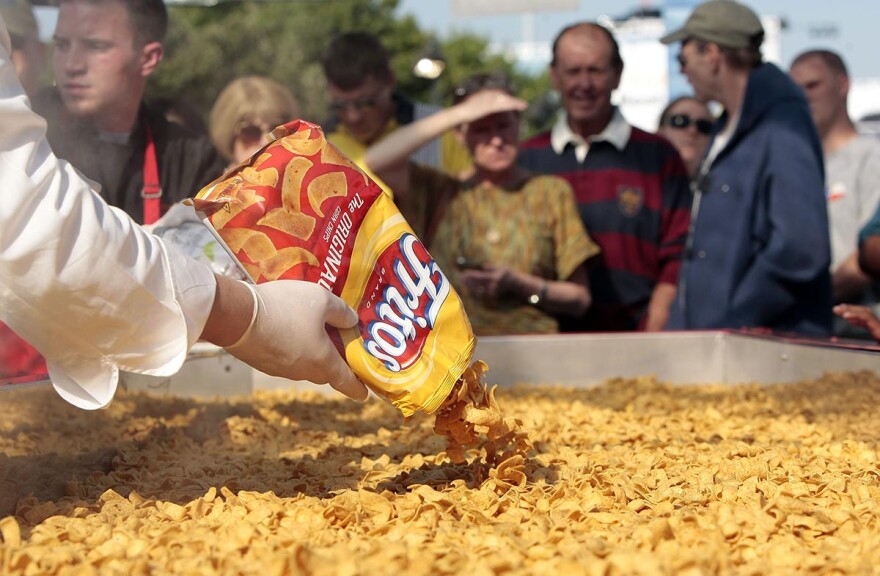Foods we consider familiar today were once considered novel at the time of their State Fair of Texas debuts — long before the era of Fried Coke, the Texas Twang-Kie and Big Red Chicken Bread.
These five foods are either a) part of the nostalgic carnival snack canon, b) converted a State Fair connection to wider fame, or c) were innovative State Fair spin-offs of foods from other regions.
Not all of these goodies are available at the State Fair today, but you can use this handy interactive map to search for concession stands throughout the fairgrounds. This year's fair runs from Sept. 27 through Oct. 20.
Let's take a look at the origins of a few delicious, old-timey State Fair foods.
» RELATED | Big Red Chicken Bread And 2 More Take Top Spots in Fair Food Contest
Fritos, 1938

In 2010, the Texas Fried Frito Pie won Best Taste in the Big Tex Choice Awards. In 2012, a 1,325-pound behemoth won the Guinness World Record for the World's Largest Fritos Chili Pie, and was prepared right at the feet of Big Tex.
But it was back in 1932 that the foundation for those quintessentially Texas creations was born.
In San Antonio, deep in the Great Depression, C.E. Doolin was looking for a snack to add to his ice cream shop to diversify his offerings. According to the Texas State Historical Association, Doolin answered an ad in the San Antonio Express-News placed by elderly man named Gustavo Olguin, who was looking to sell his original fried corn chip recipe, some equipment and retail accounts.
Doolin bought the lot for $100 and began experimenting, refining the chip in his mother's kitchen. In 1932, he named the chip Fritos, Spanish for the word "fried," and the Fritos Company was born.
In 1933, Doolin applied for a patent on equipment that would help him mass produce Fritos, catapulting the little chip with very little in it (cornmeal masa, oil and salt) into the world.
Doolin moved to Dallas the same year, and in 1936, Fritos were introduced to the public during the Texas Centennial Exposition at Fair Park.
Doolin was serious about perfecting Fritos. He even worked with Texas farmers to develop his own variety of hybrid corn grown specifically to make the chip.
But he was also a serious health enthusiast — and and ate very little of his own product.
Fletcher's Corny Dog, 1942

We can probably thank German sausage makers who immigrated to Texas in the late 19th- and early 20th centuries for the basic concept of corn-floured-and-fried tube meat. The story goes that, in the beginning, the immigrants had a tough time selling naked sausages after their arrival.
Once they began dipping their wares into batter and frying them up, they landed on a winning weiner.
But the conversation gets really contentious when debating who invented the corn-battered-and-fried-hot-dog-on-a-stick we know today. The Pronto Pup folks claim to have invented the world's first in the late 1930s in Rockaway Beach, Oregon, after rain ruined their hotdog buns. Then there's the Cozy-Dog Drive-Inn in Springfield, Illinois, which claims to have invented the very first corn dog in the early 1940s.
But it's Fletcher's Original Corny Dog that gets the crown for popularizing the food, at least in the mind of Texans.
In the 1930s, vaudeville performers Neil Fletcher, his wife Minnie and his brother Carl, were offered a food booth by State Fair of Texas officials after a performance. They began experimenting with an existing breaded hot dog that was baked in a North Dallas bakery. After frying it, instead of baking it, they decided it tasted better and was easier to make en masse.
It was also easy to tote around the fairgrounds. Ever since the "corny" dog's introduction to state fair-goers in 1942, it's been a hit.
The Fletcher's business and brand have been in the family for decades. Recently, Neil's great-granddaughter, Jace Fletcher Christensen, and her mother, Vickie Fletcher, launched a separate catering and concessions concept called Fletch, "purveyors of fine stick food."
That apparently has caused some contention in the family. Fletcher's Original Corny Dog company filed a lawsuit in September in Sherman, Texas, against the two women for alleged "willful trademark infringement and unfair competition." Christensen told The Dallas Morning News she "did not see [the lawsuit] coming" and that she's "not trying to be Fletcher's from the fair." A Fletcher's representative told KERA that Vickie Fletcher is estranged from the family.
Candy apples, 1950

Preserved, sugared fruits go back to ancient times. But the glassy, red candy-coated apples on a stick we traditionally associate with Halloween and fall festivals likely were invented in 1908 by a New Jersey candymaker trying to come up with a new Christmastime offering — perhaps accidentally.
While William W. Kolb was experimenting with red cinnamon candies at his shop, he dropped apples in the mixture. He placed them in the shop window, selling them for 5 cents each. Customers loved them. Soon candy apples were being sold all along the Jersey shore, at fairs and circuses across the country.
The glassy red treats — 200,000 of them — finally made their way to the State Fair of Texas in 1950.
That was a couple of decades before American parents began preventing their children from eating candy apples and other homemade sweets they received while trick-or-treating because of rumors of poison, needles and razor blades.
Here's a bonus modified-apple fact: The caramel apple debuted at the Fair in 1970.
The Texas Grinder, 1977
-SZTt9j27o
This serious-sounding sandwich was probably a savory mouthful of heaven. Listen to this: It was a slab of sourdough bread around beef, cheese and spices, pressed in a waffle iron and dipped in melted butter.
It had a short run and didn't get a chance to evolve into traditional fair fare. Which is surprising; it had two ingredients that should have turned it into a State Fair legend: the most Texas of all meats (beef) and gratuitious use of butter. After all, Minnesota and Iowa state fairs have their own popular beef sandwich that's still around: the Gizmo, a toasted Italian roll filled with ground beef and Italian sausage covered in a secret red sauce and topped with melted mozzarella.
In fact, the Gizmo is similar to an Italian Grinder sandwich, once a mainstay of Italian immigrants working in East Coast shipyards. Legend is that they're called "grinders" for the effort it takes to chew through the bread.
If I could time-travel back to the 1970s to eat only one thing, I'd head straight to Fair Park to hork a Texas Grinder, a delicious local spin on the northern original … dipped in melted butter, y'all.
Funnel cake, 1980

The funnel cake is similar to fitters and donuts in recipe and cooking method. Ancient Romans, Greeks, Native American tribes and other cultures around the world have eaten variations.
This particular pastry — a fried crosshatch or squiggly design sprinkled with powdered sugar — has become a family dynasty at the State Fair of Texas ever since it was introduced in 1980.
Wanda “Fernie” Winter started working at the Fair in 1969 as a way to make extra cash, and she fell in love with it. After trying funnel cake for the first time while on vacation in Branson, Missouri, in 1980, she brought the idea back to the fair.
You can get a funnel cake at several stands, but the Winters family has been selling its own version at the fair for almost four decades.
More familiar foods:
• Corn is so ancient and fundamental that it's surprising corn on the cob wasn't introduced to fair-goers until 1969. Another State Fair delicacy dipped in melted butter!
• You can get egg rolls just about anywhere these days, but when they debuted at the fair in 1977, they weren't quite as ubiquitous yet. While chefs in Hong Kong had been making spring rolls for some time, egg rolls were likely invented in New York in the 1930s.
• The turkey leg was introduced at the State Fair in 1980. There's something about holding a piece of smoked meat by the bone like a handle that feels so primal, don't you think?
Correction: This story has been updated to include details about a lawsuit filed by Fletcher's. An earlier version of this story incorrectly stated Vickie Fletcher's relationship to the Fletcher family.







